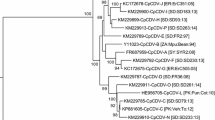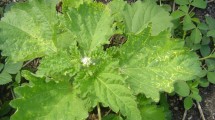Abstract
Two novel mastreviruses (genus Mastrevirus; family Geminiviridae), with proposed names chickpea chlorosis virus (CpCV) and chickpea redleaf virus, are described from chickpea (Cicer arietinum) from eastern Australia. The viruses have genomes of 2,582 and 2,605 nucleotides, respectively, and share similar features and organisation with typical dicot-infecting mastreviruses. Two distinct strains of CpCV were suggested by phylogenetic analysis. Additionally, a partial mastrevirus Rep sequence from turnip weed (Rapistrum rugosum) indicated the presence of a distinct strain of Tobacco yellow dwarf virus (TYDV). In phylogenetic analyses, isolates of Bean yellow dwarf virus, Chickpea chlorotic dwarf Pakistan virus and Chickpea chlorotic dwarf Sudan virus from southern and northern Africa and south-central and western Asia clustered separately from these three viruses from Australia. An Australian, eastern Asian, or south-eastern Asian origin for the novel mastreviruses and TYDV is discussed.



Similar content being viewed by others
References
Abraham AD, Menzel W, Varrelmann M, Vetten HJ (2009) Molecular, serological and biological variation among chickpea chlorotic stunt virus isolates from five countries of North Africa and West Asia. Arch Virol 154:791–799
Accotto GP, Donson J, Mullineaux PM (1989) Mapping of Digitaria streak virus transcripts reveals different RNA species from the same transcription unit. EMBO J 8:1033–1039
Argüello-Astorga GR, Ruiz-Medrano R (2001) An iteron-related domain is associated to Motif 1 in the replication proteins of geminiviruses: identification of potential interacting amino acid-base pairs by a comparative approach. Arch Virol 146:1465–1485
Boulton MI (2002) Functions and interactions of mastrevirus gene products. Physiol Mol Plant Pathol 60:243–255
Donson J, Accotto GP, Boulton MI, Mullineaux PM, Davies JW (1987) The nucleotide sequence of a geminivirus from Digitaria sanguinalis. Virology 161:160–169
Farzadfar SH, Pourrahim R, Golnaraghi AR, Ahoonmanesh A (2008) PCR detection and partial molecular characterization of Chickpea chlorotic dwarf virus in naturally infected sugar beet plants in Iran. J Plant Pathol 90:247–251
Fauquet CM, Briddon RW, Brown JK, Moriones E, Stanley J, Zerbini M, Zhou X (2008) Geminivirus strain demarcation and nomenclature. Arch Virol 153:783–821
Felsenstein J (1985) Confidence limits on phylogenies: an approach using the bootstrap. Evolution 39:783–791
Felsenstein J (1989) PHYLIP—Phylogeny Inference Package (Version 3.2). Cladistics 5:164–166
Fletcher MJ, Mitchell A (2007) The identity of the leafhopper vectors in the genus Orosius Distant (Hemiptera: Cicadellidae). In: Kumar PL, Jones RAC, Waliyar F (eds) 10th International Plant Virus Epidemiology Symposium, Hyderabad, Andhra Pradesh, India, pp 64
Fletcher MJ (2009) Identification keys and checklists for the leafhoppers, planthoppers and their relatives occurring in Australia and neighbouring areas (Hemiptera: Auchenorrhyncha). http://www1.dpi.nsw.gov.au/keys/leafhop/index.html
Francki RIB, Hatta T, Boccardo G, Randles JW (1980) The composition of Chloris striate mosaic virus, a geminivirus. Virology 101:233–241
Ghauri MSK (1966) Revision of the genus Orosius distant (HOMOPTERA: CICADELLOIDEA). Bull Brit Mus (Nat Hist) Entomol 18:231–252
Greber RS (1989) Biological characteristics of grass geminiviruses from eastern Australia. Ann Appl Biol 114:471–480
Guindon S, Gascuel O (2003) A simple, fast, and accurate algorithm to estimate large phylogenies by maximum likelihood. Syst Biol 52:696–704
Gutierrez C (1999) Geminivirus DNA replication. Cell Mol Life Sci 56:313–329
Hamed AA, Makkouk KM (2002) Occurrence and management of Chickpea chlorotic dwarf virus in chickpea fields in northern Sudan. Phytopathol Mediterr 41:193–198
Hassan MM (2000) Epidemiology and molecular characterization of chickpea chlorotic dwarf virus from Sudan Phytopathology Centre, Faculty of Agricultural Sciences. University of Gezira Wad Medani, Sudan
Heath L, van der Walt E, Varsani A, Martin DP (2006) Recombination patterns in Aphthoviruses mirror those found in other Picornaviruses. J Virol 80:11827–11832
Helson GAH (1950) Yellow dwarf of tobacco in Australia V. Transmission by Orosius argentatus (Evans) to some alternative host plants. Aust J Agric Res 1:144–147
Hill AV, Helson GA (1949) Distribution in Australia of three virus diseases and of their common vector Orosius argentatus (Evans). J Aust Inst Agric Sci 15:160–161
Hill AV (1950) Yellow dwarf of tobacco in Australia IV. Some host plants of the virus. Aust J Agric Res 1:141–143
Horn NM, Reddy SV, Roberts IM, Reddy DVR (1993) Chickpea chlorotic dwarf virus, a new leafhopper-transmitted geminivirus of chickpea in India. Ann Appl Biol 122:467–479
Katul L, Vetten HJ, Maiss E, Makkouk KM, Lesemann D-E, Casper R (1993) Characterisation and serology of virus-like particles associated with faba bean necrotic yellows. Ann Appl Biol 123:629–647
Knights E, Açikgöz N, Warkentin T, Bejiga G, Yadav S, Sandhu J (2007) Area, production, and distribution. In: Yadav S, Redden R, Chen W, Sharma B (eds) Chickpea breeding and management. CABI, Wallingford, pp 167–178
Kwon YJ, Lee CE (1979) On some new and little known Palaearctic species of leafhoppers (Homoptera: Auchenorrhyncha: Cicadellidae). Nat Life 9:69–97
Liu L, TV Tonder, Pietersen G, Davies JW, Stanley J (1997) Molecular characterisation of a subgroup I geminivirus from a legume in South Africa. J Gen Virol 78:2113–2117
Makkouk KM, Kumari SG (2009) Epidemiology and integrated management of persistently transmitted aphid-borne viruses of legume and cereal crops in West Asia and North Africa. Virus Res 141:209–218
Morris BAM, Richardson KA, Haley A, Zhan X, Thomas JE (1992) The nucleotide sequence of the infectious cloned DNA component of tobacco yellow dwarf virus reveals features of geminiviruses infecting monocotyledonous plants. Virology 187:633–642
Nahid N, Amin I, Mansoor S, Rybicki E, van der Walt E, Briddon R (2008) Two dicot-infecting mastreviruses (family Geminiviridae) occur in Pakistan. Arch Virol 153:1441–1451
Nawaz-ul-Rehman MS, Fauquet CM (2009) Evolution of geminiviruses and their satellites. FEBS Lett 583:1825–1832
Orozco BM, Gladfelter HJ, Settlage SB, Eagle PA, Gentry RN, Hanley-Bowdoin L (1998) Multiple cis elements contribute to geminivirus origin function. Virology 242:346–356
Pinner MS, Markham PG, Rybicki EP, Greber RS (1992) Serological relationships of geminivirus isolates from Gramineae in Australia. Plant Pathol 41:618–625
Posada D, Crandall K (1998) MODELTEST: testing the model of DNA substitution. Bioinformatics 14:817–818
Saitou N, Nei M (1987) The neighbor-joining method: a new method for reconstructing phylogenetic trees. Mol Biol Evol 4:406–425
Schalk H-J, Matzeit V, Schiller B, Schnell J, Gronenborn B (1989) Wheat dwarf virus, a geminivirus of graminaceous plants needs splicing for replication. EMBO J 8:359–364
Schwinghamer M, Schilg M, Moore K, Kumari S, Srivastava M, Wratten K, Murray G, Knights E, Bambach R, Southwell R (2003) The virus situation in chickpea, faba bean and canola in New South Wales and Southern Queensland. In: Martin R (ed) Update of research in progress at the Tamworth Agricultural Institute 2002. NSW Agriculture, Orange, pp 44–47
Schwinghamer MW, Thomas JE, Schilg M, Parry JN, Dann EK, Moore KJ, Kumari SG (2010) Mastreviruses in chickpea (Cicer arietinum) and other dicotyledonous crops and weeds in Queensland and northern New South Wales, Australia. Australas Plant Pathol (in press)
Stanley J, Bisaro DM, Briddon RW, Brown JK, Fauquet CM, Harrison BD, Rybicki EP, Stenger DC (2005) Geminiviridae. In: Fauquet CM, Mayo MA, Maniloff J, Desselberger U, Ball LA (eds) Virus Taxonomy. Eighth report of the International Committee on Taxonomy of Viruses. Elsevier Academic Press, San Diego, pp 301–326
Tamura K, Dudley J, Nei M, Kumar S (2007) MEGA4: Molecular Evolutionary Genetics Analysis (MEGA) software version 4.0. Mol Biol Evol 24:1596–1599
Thomas JE, Bowyer JW (1984) Tobacco yellow dwarf virus. CMI/AAB Descriptions of Plant Viruses, p. 4
Thomas JE, Schwinghamer MW, Parry JN, Sharman M, Schilg MA, Dann EK (2004) First report of Tomato spotted wilt virus in chickpea (Cicer arietinum) in Australia. Australas Plant Pathol 33:597–599
Thompson JD, Higgins DG, Gibson TJ (1994) CLUSTAL W: improving the sensitivity of progressive multiple sequence alignment through sequence weighting, position-specific gap penalties and weight matrix choice. Nucleic Acids Res 22:4673–4680
van Rijswijk B, Rodoni BC, Revill PA, Thomas JE, Moran JR, Harding RM (2004) Analysis of variability in partial sequences of genomes of Tobacco yellow dwarf virus isolates. Australas Plant Pathol 33:367–370
Varsani A, Shepherd D, Dent K, Monjane A, Rybicki E, Martin D (2009) A highly divergent South African geminivirus species illuminates the ancient evolutionary history of this family. Virol J 6:36
Walker JE, Saraste M, Runswick MJ, Gay NJ (1982) Distantly related sequences in the alpha- and beta-subunits of ATP synthase, myosin, kinases and other ATP-requiring enzymes and a common nucleotide binding fold. EMBO J 1:945–951
Yazdi H, Heydarnejad J, Massumi H (2008) Genome characterization and genetic diversity of beet curly top Iran virus: a geminivirus with a novel nonanucleotide. Virus Genes 36:539–545
Acknowledgments
This work was supported by the Grains Research and Development Corporation, Industry and Investment NSW (I&I NSW), and Agri-Science Queensland, a service of Department of Employment, Economic Development and Innovation (previously Queensland Department of Primary Industries, QDPI). We thank the late Michael Fuhlbohm (formerly QDPI) and Kevin Moore (I&I NSW) for assistance with the collection of some of the chickpea samples, S.G. Kumari (ICARDA) for assistance with initial TBIA tests, H.-J. Vetten (Julius Kühn Institute, Braunschweig, Germany) for a gift of antiserum to CpCDSV, B. Gronenborn (CNRS, Gif sur Yvette, France) for provision of sequence data for CpCDSV prior to publication and Murray Fletcher (I&I NSW) for advice on leafhopper vectors.
Author information
Authors and Affiliations
Corresponding author
Rights and permissions
About this article
Cite this article
Thomas, J.E., Parry, J.N., Schwinghamer, M.W. et al. Two novel mastreviruses from chickpea (Cicer arietinum) in Australia. Arch Virol 155, 1777–1788 (2010). https://doi.org/10.1007/s00705-010-0763-4
Received:
Accepted:
Published:
Issue Date:
DOI: https://doi.org/10.1007/s00705-010-0763-4




